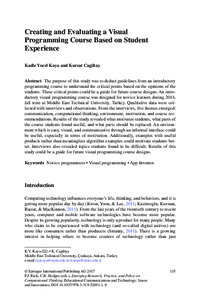Creating and Evaluating a Visual Programming Course Based on Student ExperienceKadir Yucel Kaya, Kursat Cagiltay
Zu finden in: Emerging Research, Practice, and Policy on Computational Thinking (Seite 135 bis 151), 2017
  |
 |
 Diese Seite wurde seit 8 Jahren inhaltlich nicht mehr aktualisiert.
Unter Umständen ist sie nicht mehr aktuell.
Diese Seite wurde seit 8 Jahren inhaltlich nicht mehr aktualisiert.
Unter Umständen ist sie nicht mehr aktuell.
 Zusammenfassungen
Zusammenfassungen

The purpose of this study was to deduct guidelines from an introductory programming course to understand the critical points based on the opinions of the students. These critical points could be a guide for future course designs. An introductory visual programming course was designed for novice learners during 2014, fall term at Middle East Technical University, Turkey. Qualitative data were collected with interviews and observations. From the interviews, five themes emerged: communication, computational thinking, environment, motivation, and course recommendations. Results of the study revealed what motivates students, what parts of the course students found useful, and what parts should be replaced. An environment which is easy, visual, and communicative through an informal interface could be useful, especially in terms of motivation. Additionally, examples with useful products rather than meaningless algorithm examples could motivate students better. Interviews also revealed topics students found to be difficult. Results of this study could be a guide for future visual programming course designs.
 Dieses Kapitel erwähnt ...
Dieses Kapitel erwähnt ...
 Begriffe KB IB clear |  Programmieren Programmieren programming programming
|
 Anderswo finden
Anderswo finden
 Volltext dieses Dokuments
Volltext dieses Dokuments
 |  Creating and Evaluating a Visual Programming Course Based on Student Experience: Artikel als Volltext bei Springerlink ( Creating and Evaluating a Visual Programming Course Based on Student Experience: Artikel als Volltext bei Springerlink ( : :  , 289 kByte; , 289 kByte;  : :  ) ) |
 Anderswo suchen
Anderswo suchen 
 Beat und dieses Kapitel
Beat und dieses Kapitel
Beat hat Dieses Kapitel während seiner Zeit am Institut für Medien und Schule (IMS) ins Biblionetz aufgenommen. Er hat Dieses Kapitel einmalig erfasst und bisher nicht mehr bearbeitet. Beat besitzt kein physisches, aber ein digitales Exemplar. Eine digitale Version ist auf dem Internet verfügbar (s.o.). Aufgrund der wenigen Einträge im Biblionetz scheint er es nicht wirklich gelesen zu haben. Es gibt bisher auch nur wenige Objekte im Biblionetz, die dieses Werk zitieren.










 Biblionetz-History
Biblionetz-History